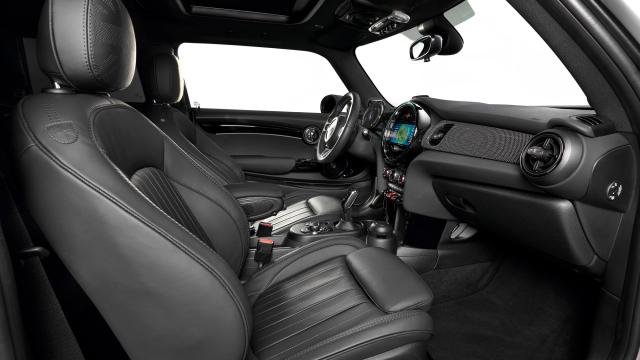Slowly but surely, automakers are beginning to shift away from offering leather upholstery as an option in their vehicles, replacing them with vegan leather or other synthetic alternatives. The latest is Mini, which announced today it’s switching to 100 per cent recycled fabrics going forward for its car interiors.
Oliver Heilmer, the British marque’s design chief, revealed the initiative to Autocar in an interview published Tuesday. Sustainability — or rather, lack thereof — is the reason, though Heilmer says customers shouldn’t expect interior quality to diminish as a result:
“It’s inventive simplicity. Materials will be recycled, but they’re luxurious at the same time. And inventive in terms of function. For instance, we used cork in the Urbanaut [concept]. The aesthetics will be coming more from a home perspective, rather than an automotive one.”
Heilmer doesn’t provide a timeline for the transition, and Mini’s press release issued for its latest hardtop and convertible models still makes mention of Nappa leather, so rest assured this isn’t happening tomorrow. When it does, though, it’ll mark a big shift for Mini. As the article states, 54 per cent of cars the company sold in the UK last year featured real leather.
While few car manufacturers have been able to entirely cut out leather, a number of them are working on it. With the Model S and Model X refresh, you can no longer purchase a new Tesla with a genuine leather interior. Ford’s Mustang Mach-E incorporates vegan leather by default, Formula 1 champion Lewis Hamilton has been pushing his employer, Mercedes-Benz, to end its reliance on leather and Volvo’s young Polestar brand uses a new synthetic material, called WeaveTech, in place of leather on the Polestar 2. (Though the Polestar 1 still apparently uses Nappa leather.)

WeaveTech in particular highlights something I see more manufacturers attempting: The development of synthetic materials that aren’t solely intended to mimic organic ones, but rather approach a unique look and feel while delivering other benefits, like weight savings or increased durability. From Polestar’s website:
WeaveTech is entirely free of animal products. It’s a water-based (not solvent-based), dirt- and moisture-resistant, modern PVC material inspired by divers’ wetsuits. It was intentionally designed to be distinct from leather, a redefinition of premium materials that has its own identity and characteristics, as opposed to a leather-like-but-animal-free upholstery. The fact that it’s free of animal products netted us a PETA award. But that’s not the only aspect of WeaveTech worth talking about.
The chemists and interior designers have reduced the amount of phthalates (see sidebar) down to 1%, compared to an industry standard of 35-45%.
Polestar’s ability to reduce phthalate content is an important point, as that’s one of the primary dangers of manufacturing synthetic fabrics. Microplastics embedded in the fibres take forever to biodegrade when disposed and release toxic chemicals into the environment when they ultimately do, leaking into our food and water. Even synthetic leather won’t be sustainable until microplastics can be knocked out, though it seems researchers are making progress on that front, using plant-based and lab-grown solutions as alternatives to plastic.
Before joining Jalopnik, I covered consumer tech — a business that faces a serious waste crisis as companies incessantly push consumers to dispose of last year’s phone in favour of a shiny new one with an imperceptibly better camera and a little more memory you don’t need. There’s been a long-overdue shift toward sustainable materials there too, but the auto industry faces a unique problem in that folks hold onto their cars longer than just about anything else. In 2019, IHS Markit predicted that by 2023, there will be about 84 million vehicles on U.S. roads that are at least 16 years old — more than twice as many as there were in 2002.
It’s not enough for seat fabrics and surfaces to be sourced responsibly — they have to stand the test of time, too. Durability, then, becomes a serious concern, as people are more likely to ditch otherwise fine-running cars once the interior really begins showing its age.
My Fiesta ST has partial-leather seats, which I opted for because the standard cloth ones felt chintzy and unpleasant to me. Had Ford offered a more sustainable, synthetic alternative, I’d have preferred that. There may not be a perfect replacement for leather yet, but it’s encouraging to see so many manufacturers moving in the right direction to come up with something better. Because leather isn’t it.
